St. Paul’s Church was built in the 16th century as a Dominican monastery church. Not only is it one of Antwerp’s most beautiful churches, it is also home to a unique Calvary Garden that consists of over sixty life-size statues.
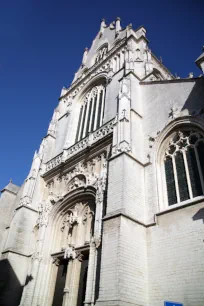
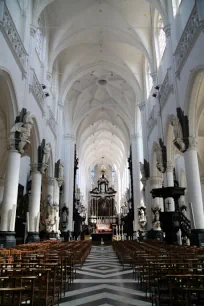

History
Construction
In 1517 the Dominican Order decided to build a new church to replace their 13th-century church that was plagued with flooding. The new church, which was known as the Blackfriars’ Church, was larger and on plot a next to the old church that was raised to protect it against floods. It was constructed in a Brabantian Gothic style, probably after a design by Domien de Waghemakere – who is best known for his completion of the spire of the Antwerp Cathedral and his design of the bourse. After de Waghemakere’s death in 1542 he was replaced by Rombout de Dryvere. The church was consecrated in 1571.
Calvinist destruction
In 1578 Calvinists ousted the Dominicans and removed all decoration inside the church, as well as parts of the choir and transept. The monastery was used as a hospital and cannon foundry. After the fall of Antwerp in 1585 the Dominicans returned and started with a thorough renovation. The choir, transept, and monastery were rebuilt in 1618-1639 and the interior of the church was redecorated in the Baroque style.
First fire
The Church’s eventful history continued in 1679 when lightning struck the tower over the crossing. The resulting fire destroyed the roof, a section of the west facade and vaults of the main nave. The damage was restored just two years later. A new, Baroque tower was built during those renovations.
Revolutions
In 1796, during the French Revolution, the French occupation forces closed all Dominican monasteries. The most important paintings were taken to France as war booty and the St. Paul’s Church and monastery were auctioned off. The buyer was a prior, which saved the church’s precious interior. Finally, in 1803, the city council acquired the church so that it could be used as a parish church, securing the future of the historic structure.
In 1830, during the Belgian Revolution, the Dutch fleet bombarded the city. This attack destroyed all the 17th-century stained-glass windows that were designed by the Dutch artist Abraham van Diepenbeeck.
Another fire
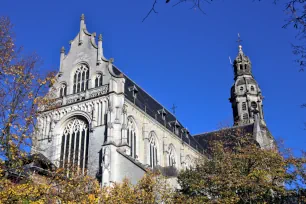
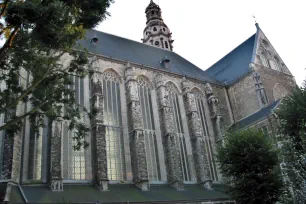
Disaster struck again in 1968, when a catastrophic fire destroyed the roof of and tower of the church. The interior suffered significant damage and the restoration lasted three decades: the roof was only rebuilt in 1988 and the interior was restored between 1994 and 1998.
The church
The St. Paul’s Church was designed by the Domien de Waghemakere, a scion of the famous family of architects who built numerous notable buildings that still stand to this day. His father Herman worked on the cathedral, St. James’s Church and Butcher’s Hall while Domien also built the Old Exchange Building, and worked on the St. Andrew’s Church, among other projects.
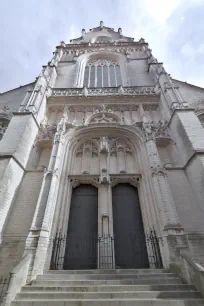
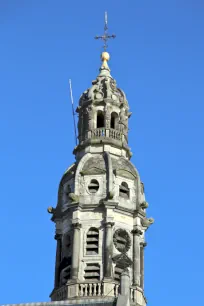
Exterior
With the St. Paul’s Church de Waghemakere created a brick-and-sandstone structure in Brabantian Late Gothic style. It is characterized by a long choir and a rather austere exterior with tall narrow windows. Austere walls were common for monastery churches in this era. Monasteries were usually integrated into the urban fabric, so they were hemmed in by houses that were often built right up against the walls. Only the porches were visible from the street.
West facade
The main, west facade, is the exception; it is the only facade of the church that is visible from the street. It is also the only ornate facade, and it was further embellished in the nineteenth century when Neo-Gothic ornaments were added during renovations. The facade is lavishly decorated with crockets, pinnacles, blind niches, and flower ornaments. The main portal is decorated with Gothic arches and blind tracery. To prevent flooding, the ground was artificially raised 1.7 meters (5.5 feet) above street level, which explains the stairs that lead up to the main portal.
Tower
The tower, which hugs the south side of the corner created by the transept and choir, is the only part of the exterior that is not in the Gothic style. This is the result of a fire in 1679 caused by a lightning strike on the tower. By that time the Gothic style had gone out of fashion so the new tower was built in the then-fashionable Baroque style. The square base of the tower is the only part that is still Gothic. On this base sits an octagonal spire crowned with a cupola, very similar in appearance to the spire of the St. Borromeo Church nearby.
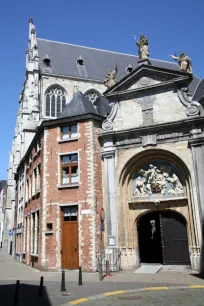
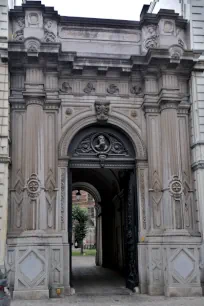
Portals
The church can be accessed through three ornamental portals, each featuring a completely different architectural style.
The main portal, on the west facade, can be accessed from the Nossestraat. This one was renovated in the nineteenth century but more or less follows the original design in the Gothic style. It features two large doorways separated by a trumeau, on which you can see an empty niche for a long lost statue.
Another portal, on the corner of the Veemarkt (a small square) and the Zwartzustersstraat, leads to an ascending passage with gravestones from the seventeenth century that is connected to the Calvary Garden and the church’s nave. This one was built in 1734 in the Baroque style. It is decorated with sculptures created by Jan Claudius de Cock. On the tympanum right above the doors you can see Catherine of Siena and at the center Mary who gives St. Dominic a rosary. Mary is shown once again on top of the pediment, this time flanked both by St. Paul and St. Dominic. Right below the pediment is a relief of the Jerusalem cross.
The tourist entrance is through yet another monumental portal. This one does not lead directly into the church, but to the grounds of the monastery. It was built in 1859-1862 as part of a garden wall that separated the monastery garden from a newly created street: the Sint-Paulusstraat. The portal was designed in 1854 by Bartholomeus de Proost in a Neoclassical style. Above the doorway, which is flanked by two Doric columns, you can see a medallion with a bust of Saint Paul. The frieze above is decorated with the symbols of the four evangelists: a winged lion (Mark) an angel (Matthew), an eagle (John) and a winged ox (Luke). To visit the church, walk through this gate, where a wide path leads along the Lourdes Garden towards a porch that gives access to the monastery. A corridor then brings you into the actual church building.
Interior
The floor plan of the St. Paul’s Church shows a six-bayed nave with two side aisles, continuing into a choir, also with six bays, that ends in a five-sided chancel. The transept is only one bay wide but the south transept extends into the Chapel of the Holy Cross.
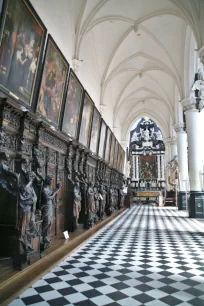
In contrast to the Gothic exterior, the interior of the church is decorated in the Baroque style. Unlike many other Baroque churches, the decorations are not overwhelming, and the dark furniture and ornaments contrast with the plain white-painted walls.
The church has interesting dimensions: it is pretty narrow – the central nave is only 11.3 meters wide (37 feet) – but with a length of 88 meters (589 feet) it is also unusually long thanks in part to its almost 39 meter-long choir (128 feet). The church also has a high vault, with the nave reaching a height of almost 26 meters (85 feet). Thanks to its long choir and high nave the church feels very spacious.
Nave
Unfortunately the stained-glass windows from the seventeenth century were never reconstructed and have been replaced with plain glass panels. They let in lots of light, giving an even more airy feeling. Even more unfortunate is the loss of several paintings that were looted by French and Austrian occupiers, who refuse to return them to this day.

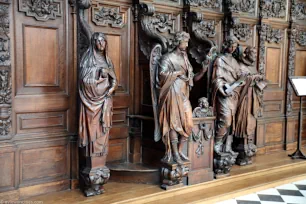
One highlight you can’t miss is the row of large Baroque paintings that adorn the blind walls of the north aisle. Together they depict Fifteen mysteries of the rosary (five joyful, five sorrowful and five glorious mysteries). They were created in 1616-1618 by eleven different artists, actively encouraged by Peter Paul Rubens, who could convince some of the city’s leading artists to contribute works to this cycle of paintings. Rubens himself created «The Flagellation», the seventh counting from the left. Anthony Van Dyck, who was barely nineteen when he created «Bearing of the Cross» also participated; Other artists include Jacob Jordaens «Crucifixion»; David Teniers «Gethsemane»; and Hendrick van Balen «The Annunciation».
Below the paintings, and across the nave against the wall of the south aisle, is dark wooden paneling with pews for the churchwardens and ten confessionals. They were created in 1657-1659 and are decorated with forty expressive life-size wooden statues, the work of Pieter Verbrugghen.
On the twelve pillars that support the nave you can see statues of the Apostles, sculpted in the early eighteenth century by Michiel van der Voort the Elder, who is also responsible for several of the Calvary sculptures outside.
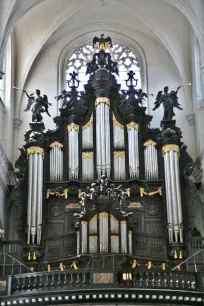
In front of the west wall of the nave stands the massive organ, originally from the 1650s and built by Nicolaas van Hagen, who created what was at the time the largest organ in the Low Countries. The oak case was created in 1654-1658 by Pieter Verbrugghen. The organ was renovated and further expanded by Jean-Baptiste Forceville in 1730-1732. In 1824 it was renovated by Jean-Joseph Delhaye and again in 1843 by François-Bernard Loret.
The oak pulpit in the nave was created in 1874 by the sculptors duo of De Boeck & Van Wint. It is decorated with beautiful relief panels that depict scenes from the bible. Two lions guard the steps to the pulpit and sculptures on the base show the four evangelists and a ferocious-looking St. Paul, holding his sword.
Monastery

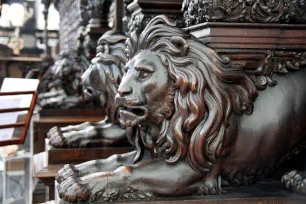
An ornate door near the organ gives access to a wing of the monastery, where you can visit two corridors, including one known as the Way of the Cross Chapel, which features wooden sculpted panels that depict the fourteen stations of the cross. The relief panels were made in 1888-1889 by the Antwerp sculptors Jean-Baptist de Boeck and Jean-Baptist van Wint. The other corridor forms the connection between the tourist entrance and the church. Here you can see a series of religious paintings from the 17th and 18th century.
Choir
Two monumental Lion Gates from around 1650 connect the choir to the sacristy (north) and treasury (south). They get their name from the impressively sculpted lion statues that guard the doors, two on each side.
Next to these gates are the choir stalls which were created by Pieter Verbrugghen. They are adorned with beautiful spiraling columns featuring floral motifs, festoons, and small busts of putti. The painted coats of arms between the columns refer to donors.
Before the St. Paul’s Church became a parish church, there was a choir screen that allowed the Dominicans to separate the choir from the nave, which was open to the public. You can still see where the choir screen was attached to the walls.
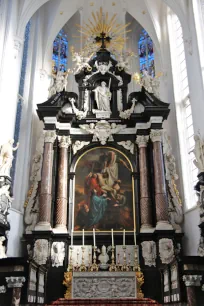

Chancel
The focal point of the church is the high altar in the chancel. The monumental altar, with its massive Corinthian columns, was consecrated in 1670. It was designed by Frans Van Sterbeeck and executed by Pieter Verbrugghen and his namesake son. In the central niche at the top stands the statue of St. Paul, to whom the church is dedicated. Angels above him offer him a laurel wreath and a palm. On either side are two allegorical statues: «Faith» (holding a cross and chalice) on the left and «Truth» (holding a book, palm and sun) on the right.
The main altarpiece depicts the «Descent from the Cross» by C. Cels from 1807, which replaced the original painting by Rubens «The Vision of Saint Dominic», which was looted in 1794 by French occupiers and is now in a museum in Lyon. The altarpiece features a system that can alternate between two paintings. The second painting was originally «The Martyrdom of St Paul» by Theodoor Boeyermans, but this was also looted and is now in a church in France.
Below the main altarpiece are busts of the four great western Church Fathers: Jerome, Ambrose, Gregory and Augustine.
Against the side walls of the chancel you can see four large funerary monuments. The first Baroque monument on the north side was created in 1635 by Hans Van Mildert for bishop Michael van Ophoven; its Baroque design is attributed to P.P. Rubens. Adjacent is the monument for the parents of another bishop, Ambrosius Capello. It was created either by Pieter Verbrugghen or his namesake son.

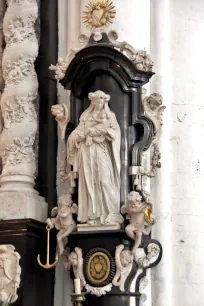
The marble monument opposite dates from around 1630 and was the work of Andreas de Nole for Henri de Varick, margrave of Antwerp and his wife, Anna Damant. It shows the pair kneeling and praying. The monument next to it is of a more recent date: It was created in 1868 for the parents of a churchwarden. The sculptors are Van Wint & De Boeck – who are also responsible for the pulpit in the nave – and shows a statue of John the Baptist at the top and Mary handing a rosary to Saint Dominic below.
Treasury
The lion gate on the south side gives access to the treasury, where you can see a display of reliquaries, liturgical vessels, monstrances and many more religious items. One of the highlights is a large solar monstrance created in 1839 by Joannes Petrus Verschuylen. The precious liturgical object weighs over 10 kg and is decorated with 554 diamonds. The silver sculptures below the rays depict the conversion of Paul the Apostle and shows St. Paul the moment after he fell off his horse. Another highlight is a gilded silver sculpture of Peter and Paul. Peter is shown with the keys of heaven in his hand while Paul is depicted holding his sword, the instrument of his martyrdom.
Transept
In the north transept is the Mary Chapel, with another altar known as the Rosary Altar. It features a 19th-century copy of Caravaggio’s «La Madonna de Rosario». The original was confiscated by Austrian occupiers and is now in the Kunsthistorisches Museum in Vienna. Nearby, on the north wall, is one more Rubens painting: «Adoration of the Shepherds», from 1609.
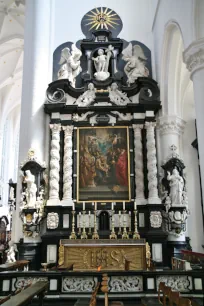
On the other side of the Mary Chapel, right on the corner of the north transept and choir, you can see another highlight: a marble sculpture group that depicts Rose of Lima surrounded by angels. This masterwork was created in 1668 by the Flemish sculptor Artus Quellinus the Younger.
In the south transept, at the beautiful «Altar of the Sweet Jesus» there is another masterwork known as «The Disputation of the Holy Sacrament», a large painting by Rubens from around 1609. This painting still bears scars from the rescue operation of 1968, when a fire ravaged the church. Neighbors and firemen tried to salvage the artworks, but the canvas of this painting was too large so they cut the painting out of its canvas.
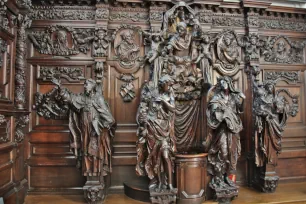
At the end of the south transept we find the Chapel of the Holy Cross. Its marble Altar of the Holy Cross was created in 1654 by Pieter Verbrugghen. The altarpiece is from the same year and shows «Lamentation of Christ», a painting attributed to Gaspar De Crayer. Turn around and you can see one of the church’s highlights: an elaborately sculpted wooden confessional, which is by many considered the most beautiful in the world. It was sculpted in 1684 by Willem Kerricx the Elder and represents «The Last Judgment».

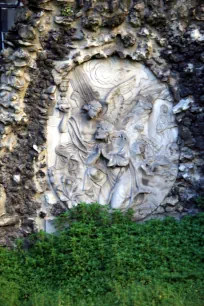
Calvary Garden
For Dominicans a pilgrimage to the Holy Land was an important life goal but by the end of the 17th century, this had become increasingly difficult due to instability in Jerusalem. So in 1697 plans were made by two Dominican brothers to create a reconstruction of Golgotha, the mount on which Jesus was crucified.
A graveyard right next to the south wall of the church was allocated as the spot to build a display that would evoke Golgotha. It is known as the Calvary Garden since Calvary is the Latin name for Golgotha. Construction lasted until 1734 but statues continued to be added until 1747.
The garden consists of sixty-three life-size statues and four oval-shaped reliefs. The majority of the statues were created by local artists, including some well-known sculptors such as Michiel van der Voort the Elder, Alexander van Papenhoven, Jan Peter van Baurscheit the Elder and Jan Claudius de Cock. The four reliefs were created in 1741 by Willem Ignatius Kerricx.
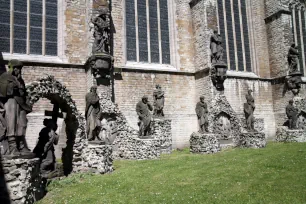
The garden can be divided into four themes. At the center is the Path of Angels, a path lined with ten statues of mourning angels that leads you to the Tomb of Jesus. Bernini’s angels on the Ponte Sant’Angelo were the inspiration for this path. To the left of this path stand four main and twelve minor prophets. On the right are the four evangelists. The focal point of the theatrical display is the Calvary Mount itself, an artificial rock with three terraces on which stand even more statues, including those of two Dominicans. The first two statues that greet you at the start of the Path of Angels are also Dominicans.
You can access the Calvary Garden through the door on the south side, near the organ. Walk through the passage; a door on the left leads outside, straight into the garden.
- Next: Vlaeykensgang
- More Sights & Attractions in Antwerp

